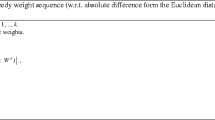Abstract
A new framework for computing the Euclidean distance and weighted distance from the boundary of a given digitized shape is presented. The distance is calculated with sub-pixel accuracy. The algorithm is based on a equal distance contour evolution process. The moving contour is embedded as a level set in a time varying function of higher dimension. This representation of the evolving contour makes possible the use of an accurate and stable numerical scheme, due to Osher and Sethian [22]. The relation between the classical shape from shading problem and the weighted distance transform is presented, as well as an algorithm that calculates the geodesic distance transform on surfaces.
Similar content being viewed by others
References
M. Bichsel and A.P. Pentland, “A simple algorithm for shape from shading,” in Proceedings IEEE CVPR, Champaign, Illinois, May 1992, pp. 459–465.
H. Blum, “Biological shape and visual science (part I),” J. Theor. Biol., Vol. 38, pp. 205–287, 1973.
R.W. Brockett and P. Maragos, “Evolution equations for continuous-scale morphology” in Proceedings IEEE International Conference on Acoustics, Speech, and Signal Processing, San Francisco, California, March 1992, pp. 1–4.
A.M. Bruckstein, “On shape from shading,” Comput. Vision Graphics Image Process., Vol. 44, pp. 139–154, 1988.
L. Calabi and W.E. Hartnett, “Shape recognition, prairie fires, convex deficiencies and skeletons,” Am. Math. Mon., Vol. 75, pp. 335–342, 1968.
P. Danielson, “Euclidean distance mapping,” Computer Graphics and Image Processing, Vol. 14, pp. 227–248, 1980.
P. Dupuis and J. Oliensis, “Direct method for reconstructing shape from shading,” in Proceedings IEEE CVPR, Champaign, Illinois, May 1992, pp. 453–458.
B.K.P. Horn, “Height and gradient from shading,” Int. J. of Comput. Vision, Vol. 5, pp. 37–75, 1990.
B.K.P. Horn and M.J. Brooks (Eds.), Shape from Shading, MIT Press: Cambridge, MA, 1989.
K. Ikeuchi and B.K.P. Horn, “Numerical shape from shading and occluding boundaries,” Artificial Intelligence, Vol. 17, Nos. 1–3, pp. 141–184, 1981, also in Horn and Brooks, 1989.
R. Kimmel, “Shape from shading via level sets,” M.Sc. Thesis (in Hebrew), Technion, Israel Institute of Technology, June 1992.
R. Kimmel, A. Amir, and A.M. Bruckstein, “Finding shortest paths on graph surfaces,” IEEE Trans. on PAMI, Vol. 17, No. 6, pp. 635–640, 1995.
R. Kimmel and A.M. Bruckstein, “Shape from shading via level sets,” Center for Intelligent Systems Report CIS#9209, Technion, Israel Institute of Technology, Israel, June 1992.
R. Kimmel and A.M. Bruckstein, “Distance maps and weighted distance transforms,” in Proceedings SPIE-Geometric Methods in Computer Vision II, San Diego, California, July 1993, Vol. 2031, pp. 259–268.
R. Kimmel and A.M. Bruckstein, “Shape offsets via level sets,” CAD, Vol. 25, No. 5, pp. 154–162, 1993.
R.J.Le Veque, Numerical Methods for Conservation Laws, Lectures in Mathematics, Birkhauser Verlag: Basel, 1992.
F. Leymarie and M.D. Levine, “Fast raster scan distance transform on the discrete rectangular lattice,” CVGIP: Image Understanding, Vol. 55, No. 1, pp. 84–94, 1992.
P.L. Lions, E. Rouy, and A. Tourin, “Shape-from-shading, viscosity solutions and edges,” Numerische Mathematik, Vol. 64, pp. 323–353, 1993.
J.S.B. Mitchell, D. Payton, and D. Keirsey, “Planning and reasoning for autonomous vehicle control,” International Journal of Intelligent Systems, Vol. 2, pp. 129–198, 1987.
S. Osher and L. Rudin, “Rapid convergence of approximate solutions to shape-from-shading problem,” Technical Report, Cognitech Inc., 1993, Unpublished.
S. Osher and C.W. Shu, “High-order essentially nonoscillatory schemes for Hamilton-Jacobi equations,” SIAM J. Numer. Anal., Vol. 28, No. 4, pp. 907–922, 1991.
S.J. Osher and J.A. Sethian, “Fronts propagating with curvature dependent speed: Algorithms based on Hamilton-Jacobi formulations,” J. of Comp. Phys., Vol. 79, pp. 12–49, 1988.
A.P. Pentland, “Local shading analysis,” IEEE Trans. on PAMI, Vol. 6, No. 2, pp. 170–187, 1984, also in Horn and Brooks, 1989.
A.P. Pentland, “Linear shape from shading,” Int. J. of Comput. Vision, Vol. 4, pp. 153–162, 1990.
Y. Pnueli and A.M. Bruckstein, “DigiDurer—A digital engraving system,” to appear in The Visual Computer, 1993.
E. Rouy and A. Tourin, “A viscosity solutions approach to shape-from-shading,” SIAM. J. Numer. Anal., Vol. 29, No. 3, pp. 867–884, 1992.
G. Sapiro, R. Kimmel, D. Shaked, B. Kimia, and A.M. Bruckstein, “Implementing continuous-scale morphology via curve evolution,” Pattern Recognition, Vol. 26, No. 9, pp. 1363–1372, 1993.
G. Sapiro and A. Tannenbaum, “Affine invariant scale-space,” Int. J. Comp. Vision, Vol. 11, No. 1, pp. 25–44, 1993.
J.A. Sethian, “Curvature and the evolution of fronts,” Commun. in Math. Phys., Vol. 101, pp. 487–499, 1985.
J.A. Sethian, “A review of recent numerical algorithms for hypersurfaces moving with curvature dependent speed,” J. of Diff. Geom., Vol. 33, pp. 131–161, 1989.
M. Sussman, P. Smereka, and S.J. Osher, “A level set approach for computing solutions to incompressible two-phase flow,” Department of Math, UCLA CAM Report 93–18, UCLA, Los Angeles, CA, 90024–1555, June 1993.
P.W. Verbeek and B.J.H. Verwer, “Shading from shape, the eikonal equation solved by gray-weighted distance transform,” Pattern Recognition Letters, Vol. 11, pp. 681–690, 1990.
L. Vincent, “Exact Euclidean distance function by chain propagation,” in Proceedings IEEE CVPR, May 1991, pp. 520–525.
S.D. Yanowitz and A.M. Bruckstein, “A new method for image segmentation,” Computer Vision, Graphics, and Image Processing, Vol. 46, pp. 82–95, 1989.
Author information
Authors and Affiliations
Rights and permissions
About this article
Cite this article
Kimmel, R., Kiryati, N. & Bruckstein, A.M. Sub-pixel distance maps and weighted distance transforms. J Math Imaging Vis 6, 223–233 (1996). https://doi.org/10.1007/BF00119840
Issue Date:
DOI: https://doi.org/10.1007/BF00119840




